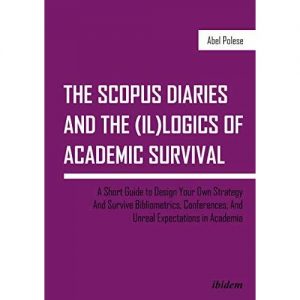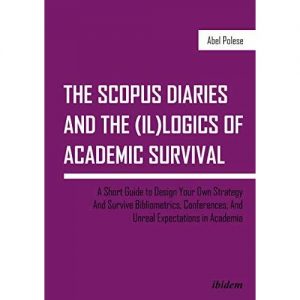Book Review: The Scopus Diaries and the (Il)Logics of Academic Survival
After thinking about it for quite a long time, you have finally made the leap. You have started a PhD. After a few weeks, you’re already deep in the mysterious world of academic research. Before starting your career as a researcher, the ways of academia seemed obscure. But surely this would pass, and it all would become clear after a while. Well, if you’re like me, you’re still in the dark, regardless of whether you’re months away from handing in your thesis. But it doesn’t have to be this way.
Researchers have to constantly push back at the limits of knowledge, which, in itself, creates a climate of uncertainty. It is therefore a shame that certainty lies in the fact that, no matter what academic field we’re in, we all face similar problems that are inherent to academia. It is especially hard for new researchers ‘who are parachuted into “you should do this, this and this,” without revealing the hidden (and sometimes dark) mechanisms behind a number of practices’ (17). During the course of my PhD, I have been feeling concerned about the future, while simultaneously not able to discern what exactly I was concerned about. In his book The Scopus Diaries and the (Il)logics of Academic Survival, Abel Polese helps raise the veil that surrounds many of the issues we face as academic researchers.

Polese starts by clarifying the framework of academia. In his foreword, he explains that due to the recent democratisation of higher education, along with limited funding, there is a need to objectively measure academic research in order to better distribute the available resources. Because carefully assessing the work of every academic is highly impractical, there needs to be a shortcut. The author explains that this is how publication in a top peer-reviewed journal has now become synonymous with quality research. Unfortunately, by attempting to classify research quality, this system instigates a ‘publish or perish’ mentality. Since top articles have become the golden standard to measure research quality, the value of a researcher now depends directly on their number of Scopus publications, making research quality synonymous with research performance. Instead of encouraging researchers to invest time and effort into well-thought-out research, the system pushes us to publish as many top articles as possible and thus ‘produces more fetishes than career advice’ (15).

The author also points out that our academic tasks do not stop at publishing in Scopus. We have to juggle teaching activities, peer reviewing, the hunt for funding, attending conferences, establishing collaborations… We are expected to do them all, at the risk of being deemed unfit to work in academia if we do not. This book reminds us that researchers are human. It reminds us that having our own goals and personal boundaries is okay, and that setting these boundaries and goals mindfully might even help us be good at our job. Polese states: ‘My goal is to help you to think of your own career strategy while remaining healthy in your mind’ (16). After all, ‘only you know how much stress you can handle’ (17). And that is a reminder that all of us need to hear.
The Scopus Diaries is written like a FAQ list that you can pop in and out of whenever an issue arises. By describing practical approaches to mysterious things like ‘how to publish a good abstract’ or ‘how to get your paper accepted’, Polese demystifies the academic idiosyncrasies we are all faced with throughout our career, and by explaining the inner workings of academia, makes things seem more achievable.
You might not think so at first, but writing is a central aspect of a scientist’s life. We scientists frequently have to write abstracts, reports, papers, grants and so forth without any guidelines, in a language that often is not even our own. Scientific writing, like any other type of writing, has its own set of rules. If these rules aren’t made clear to you by attending a class, receiving advice from a mentor or painstakingly figuring them out with time, having your abstract or paper rejected often feels like an unsolvable personal failure. The author advises that, in order to produce a good abstract, presentation is key. ‘The package is as important as its content. […] You will often tend to think better of authors sending a tidy abstract, even more if it is nicely written, regardless of content’ (31). Beyond aesthetics, one should focus on having a clear message: ‘When people remember your paper, what is the jingle that you want them to sing in their head?’ (39). Lastly, the author explains that if your abstract or paper keeps getting rejected, there might not be anything wrong with it; you might just be submitting to the wrong journal. Try re-submitting to a journal whose interests are more in line with the scope of your work.
You might not notice the redundancy of certain sections if you’re reading this book as an FAQ, but it could become quite obvious if you’re reading it back to back, as I did. The author sometimes divides his questions into rather subjective chapters: beyond the chapters ‘Writing’ and ‘Publishing’, which circumscribe their respective topics quite accurately, the chapters ‘Growing’, ‘Shining’ and ‘Niching’ are more ambiguous and cover anything from book publishing, science communication and predatory journals to why to organize a panel at a conference, what to put in your bibliography and what is a ‘good’ publication. I believe restructuring some sections into more general topics would have made for a smoother read.
While many issues underlying academia are common to different fields, this work adopts a social science angle on these issues, which does diverge quite drastically from my own field. Indeed, most of the chapter ‘Growing’ discusses book publication and gives advice that a life scientist might never get to use. Because life science is considered a ‘fast’ field, life scientists rarely publish books, as their content is bound to rapidly become obsolete. Similarly, Polese addresses whether or not to have co-authors. While this choice might be feasible in ‘slower’ fields, it is next to impossible in mine: experimental immunology papers often comprise an average of ten people.
In spite of these differences, this book remains a useful eye-opening guide for new academics who haven’t been reassured that they are allowed to make their own career and life choices.





























































































